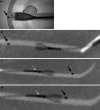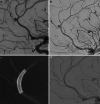The p48MW Flow Diverter-Initial Human Experience
- PMID: 31435722
- PMCID: PMC7943536
- DOI: 10.1007/s00062-019-00827-8
The p48MW Flow Diverter-Initial Human Experience
Abstract
Background and purpose: The use of flow diverters to treat aneurysms arising from small caliber parent vessels has been reported. This article reports the results of the first in experiences with the p48MW (p48 Movable Wire) in humans, a device specifically designed to target vessels 1.75-3 mm in diameter.
Methods: This monocentric study retrospectively reviewed the prospectively maintained database to identify all patients treated with the p48MW device between January 2017 and January 2019 at this institution. Patient demographics, aneurysm characteristics, angiographic and clinical follow-up were recorded as well as complications.
Results: A total of 25 patients (20 female) with an average age of 55 ± 12.9 years (range 34-84) with 25 aneurysms were identified. The majority of the aneurysms was located in the anterior circulation (19/25, 76%). The average aneurysm dome width was 3.98 ± 3.6 mm (range 1.2-13 mm). Complete occlusion was seen in 18/24 (75%) aneurysms with neck remnants in 1/24 (4.2%) and continued aneurysm filling seen in the remaining cases (5/24, 20.8%). Adequate occlusion was seen in 79.2% of aneurysms (Raymond Roy Classification [RRC] grade I or II) during the follow-up period. There was a single technical complication with inappropriate deployment of the first p48MW. There was a single clinical complication (4%); however, the patient made a complete recovery (modified Rankin Scale [mRS] 0) and one patient died secondary to uncontrollable status epilepticus following acute subarachnoid hemorrhage unrelated to the treatment.
Conclusion: The p48MW is safe and effective for the treatment of aneurysms including those arising from distal vessels.
Keywords: Aneurysm; Flow diverter; New devices; P48 MW; Stent.
Conflict of interest statement
P. Bhogal serves as a proctor and consultant for phenox. H. Henkes is a co-founder and shareholder of phenox. C. Bleise, J. Chudyk, I. Lylyk, R. Viso, N. Perez and P. Lylyk declare that they have no competing interests.
Figures





References
MeSH terms
LinkOut - more resources
Full Text Sources
Medical

